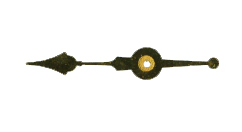Atom, Planet: Cameraless Photography
While most photography employs a lens, and either film or a digital sensor, this series explores ways of generating images on photographic paper without using a camera or negative. The source of inspiration for inventing processes that inform the resulting photograph is the dialogue that occurs between painters or sculptors, and their chosen medium. Another is the scientific method, where you observe phenomena, formulate a hypothesis, test it with experiments, use careful measurements, note variables, observe results, and use this information to build an image.
While still working with photo paper, light, and chemistry, I revisit some historic processes like Man Ray’s photogram, Pierre Cordier’s chemigram, and lumen printing, and also invent other ways of producing images without using a negative. These processes are utilizing optical situations, or chemical reactions, or a combination of the two. Applying glue as a resist and digging down to the photo paper surface with alternating photo chemicals causes an image to emerge on the paper in the form of a chemical painting. Some of these cameraless experiments include painting bleach onto blackened photo paper, building layered piles of glass and eggshells and moving around them with a flashlight to make an exposure, and growing a self-replicating garden of mold that feeds on silver gelatin paper. In one image, over 100 medicines, spices, and household cleaners were applied to photo paper and run through darkroom chemistry to test for colors and textures. The methods are an unorthodox collection of materials and techniques from the domestic and scientific realms, brought into the darkroom, often coaxing or scrubbing an image into the photographic paper. Some images are made in the dark and some in daylight, some processes are additive and others reductive, the result is a series of giant (50 x 111 inch) and many smaller photographs. The imagery emerges as circles and spheres, meant to represent planets and atoms, to visualize the macrocosm and the microcosm of life as we know it.
The scale has a relationship to large painting; the physical demands of the area being treated require a bodily presence in the piece while building it, exploring as if it were a landscape. The scale impacts the subject matter, the work more often addresses the cosmological realm than the atomic, but this obsession with circles is also related to a search for a sense of wholeness.
Photography is a very young and exciting medium, and there is so much undiscovered terrain. In some ways, it stands at a precipice: digital photography is eroding the availability of some analog materials, and the study and use of silver gelatin papers. I am working to develop these processes, and to pose interesting questions about what photography is, and what it can be.
